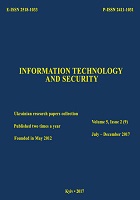The virtual private networks protocols: features of creation and perspective of development
DOI:
https://doi.org/10.20535/2411-1031.2017.5.2.136947Keywords:
Virtual private networks, the crypto protocol, IPSec, PPTP, L2TP, TLS, tunneling, authentication, encryption.Abstract
In this article, the analysis of the main protocols of the creation of the virtual private networks which are widely used in case of creation of the protected connections on networks of general purpose is carried out. Possible types of implementations of the virtual private networks are marked and examples of the modern telecommunication equipment which uses the virtual protected connections for information security which is transferred by open channels of communication are given. At the same time, it is certain that all leading telecommunication companies have the equipment for the creation of the protected virtual area networks. Characteristics of such main protocols as IPSec, by PPTP, L2TP and TLS are provided. Their structure is considered and analyzed, figures of the logical creation of each protocol and also their advantage and shortcomings are given. The list of cryptographic algorithms which are used in these protocols is provided. The analyzed protocols work at different levels of the open system interconnection model but have common features of creation and cryptographic algorithms which are used. Yes, each of the analyzed protocols has subprotocols which are responsible for tunneling, authentication, encryption, and support of the integrity of data. However, each of them contains the possible implementations of cryptographic algorithms. It is certain that perspective option of development the virtual private area networks technologies for information security which is the property of the state during its transfer over open channels of communication are used in an implementation of the virtual private area networks of cryptographic algorithms which are passed a State expertise. It can be an algorithm of block encryption of GSTU 7624: 2014, hashing algorithm GSTU 7564: 2014 and algorithm of the digital signature of GSTU 4145: 2002.
References
RFC Editor. [Online]. Available: www.rfc-editor.org. Accessed on: Sept.14, 2017.
V.V. Maiorov, “Modern VPN-networks”. Scientific works КSТU, № 13, pp. 121-128, 2016.
І.І. Pаrhоmеnко, О.О. Кvаchuк, А.О. Vоsкоbоjnікоv, and G.V. Pоpоv, ”Tunneling as a way to protect corporate information”, Ukrainian Information Security Research Journal, Vol. 14, № 1, pp. 36-39, 2012.
doi: 10.18372/2410-7840.14.2059.
M.M. Braіlovskyy, T.V. Pogrebna, and O.V. Ptashok, “VPN networks and problems of their defence”, Telecommunications and Information Technologies, № 1, pp. 76-80, 2014.
Cisco. [Online]. Available: www.cisco.com. Accessed on: Sept.10, 2017.
Hewlett Packard Enterprise. [Online]. Available: https://www.hpe.com. Accessed on: Sept.10, 2017.
D-Link. [Online]. Available: http://www.dlink.ua. Accessed on: Sept.10, 2017.
K. Hamzeh, G. Pall, W. Verthein, J. Taarud, W. Little, and G. Zorn, “RFC 2637 Point-to-Point Tunneling Protocol (PPTP)”. [Online]. Available: https://tools.ietf.org/html/rfc2637. Accessed on: Sept.10, 2017.
G. Pall, and G. Zorn, “RFC 3078 Microsoft Point-To-Point Encryption (MPPE) Protocol”. March 2001. [Online]. Available: https://tools.ietf.org/html/rfc3078. Accessed on: Sept.10, 2017.
S. Kent, and K. Seo, “RFC 4301 Security Architecture for the Internet Protocol”. [Online]. Available: https://tools.ietf.org/html/rfc4301. Accessed on: Sept.10, 2017.
B. Patel, B. Aboba, W. Dixon, G. Zorn, and S. Booth, “RFC 3193 Securing L2TP using IPsec”. [Online]. Available: https://tools.ietf.org/html/rfc3193. Accessed on: Sept.10, 2017.
W. Townsley, A. Valencia, A. Rubens, G. Pall, G. Zorn, and B. Palter. “RFC 2661 Layer Two Tunneling Protocol ”L2TP”. [Online]. Available: https://tools.ietf.org/html/rfc2661. Accessed on: Sept.10, 2017.
T. Dierks, and E. Rescorla. “RFC 5246 The Transport Layer Security (TLS) Protocol Version 1.2”. [Online]. Available: https://tools.ietf.org/html/rfc5246. Accessed on: Sept.10, 2017.
Downloads
Published
How to Cite
Issue
Section
License
Copyright (c) 2020 Collection "Information technology and security"

This work is licensed under a Creative Commons Attribution 4.0 International License.
The authors that are published in this collection, agree to the following terms:
- The authors reserve the right to authorship of their work and pass the collection right of first publication this work is licensed under the Creative Commons Attribution License, which allows others to freely distribute the published work with the obligatory reference to the authors of the original work and the first publication of the work in this collection.
- The authors have the right to conclude an agreement on exclusive distribution of the work in the form in which it was published this anthology (for example, to place the work in a digital repository institution or to publish in the structure of the monograph), provided that references to the first publication of the work in this collection.
- Policy of the journal allows and encourages the placement of authors on the Internet (for example, in storage facilities or on personal web sites) the manuscript of the work, prior to the submission of the manuscript to the editor, and during its editorial processing, as it contributes to productive scientific discussion and positive effect on the efficiency and dynamics of citations of published work (see The Effect of Open Access).

